CHEVROLET BLAZER 1993 Owners Manual
Manufacturer: CHEVROLET, Model Year: 1993, Model line: BLAZER, Model: CHEVROLET BLAZER 1993Pages: 386, PDF Size: 20.7 MB
Page 321 of 386
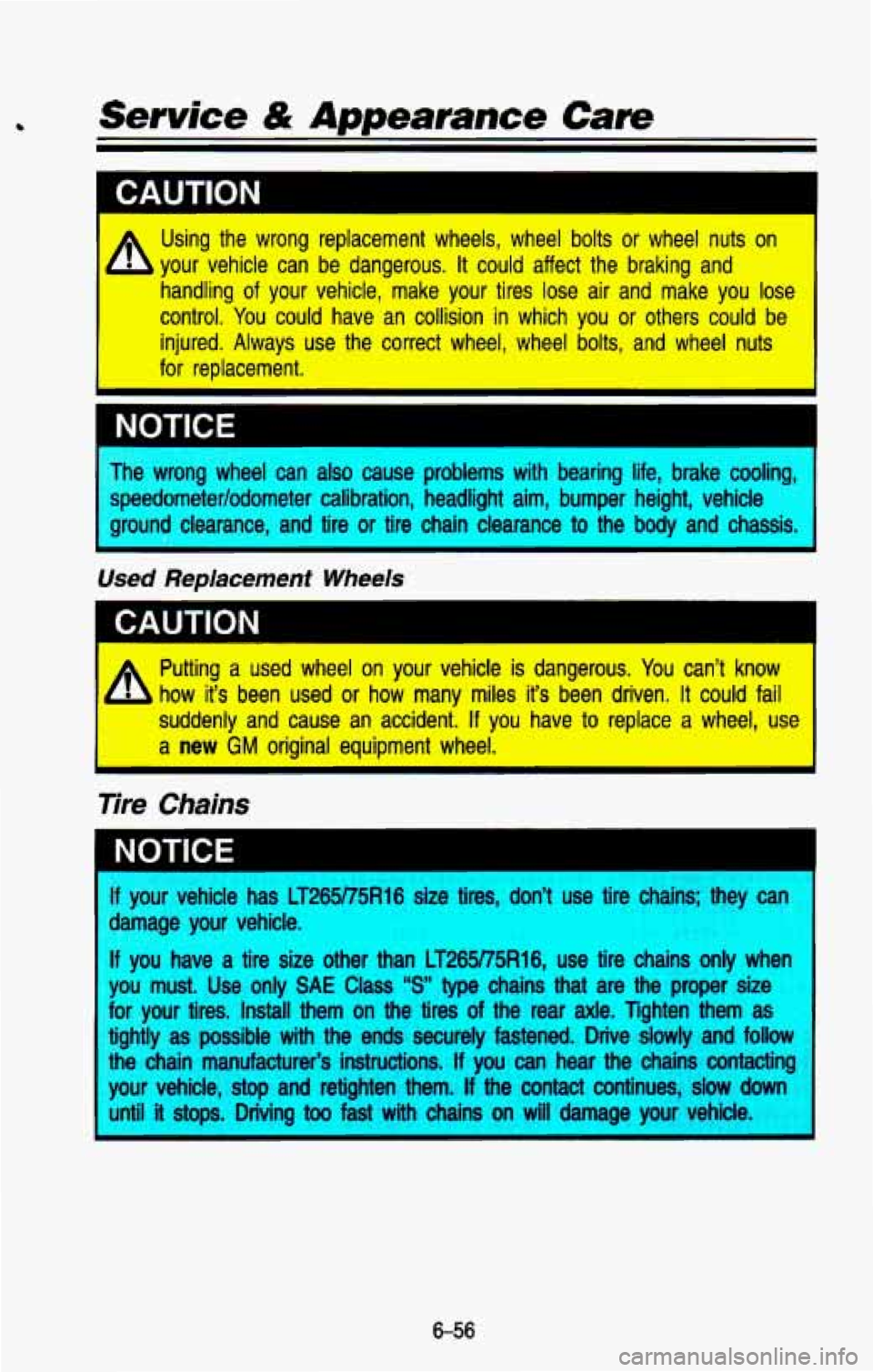
I CAUTION I
A Using the wrong replacement wheels, wheel bolts or wheel nuts on
your vehicle can be dangerous.
It could affect the braking and
handling
of your vehicle, make your tires lose air and make you lose
control. You could have an collision in which you or others could be
injured. Always use the correct wheel, wheel
bolts, and wheel nuts
for replacement.
I
I
I The wrong wheel can also cause problems with bearing life, brake cooling,
speedometerlodometer calibration, headlight aim, bumper height, vehicle
ground clearance, and tire
or tire chain clearance to the body and chassis.
A Putting a used wheel on your vehicle is dangerous. You can't know
how it's been used or how many miles it's been driven. It could fail
suddenly and cause an accident. If you have to replace a wheel, use
a new GM original equipment wheel,
I
Tire Chains
rNOTICE 'If put vehicle has LT265/75R16 size tires, don't use tire chams; they i can!
damage your vehicle.
6-56
Page 322 of 386
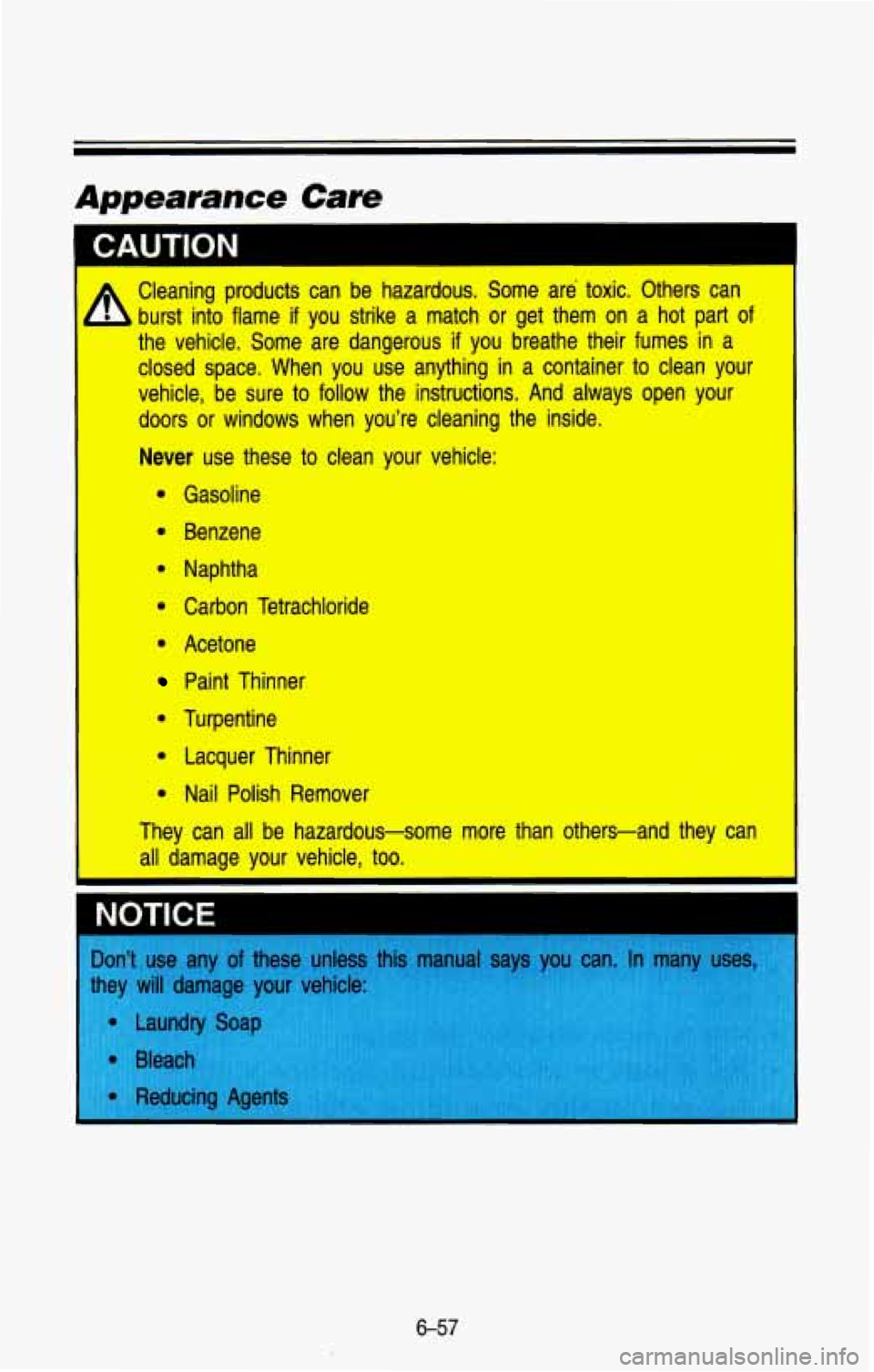
I
Cleaning products urst into flame
if
the vehicle. Some can
be hazardous. Some are' toxic. Others can
you strike a match or get them on a hot part of
are dangerous if you breathe their fumes in a
closed space. When you use anything in a container
to clean your
vehicle, be sure
to follow the instructions. And always open your
doors or windows when you're cleaning the inside.
Never use these to clean your vehicle:
0 Gasoline
0 Benzene
0 Naphtha
0 Carbon Tetrachloride
Acetone
Paint Thinner
0 Turpentine
0 Lacquer Thinner
* Nail Polish Remover
They can all be hazardous-some more than others-and
they can
all damage your vehicle, too.
NOTICE
I
I I
6-57
Page 323 of 386
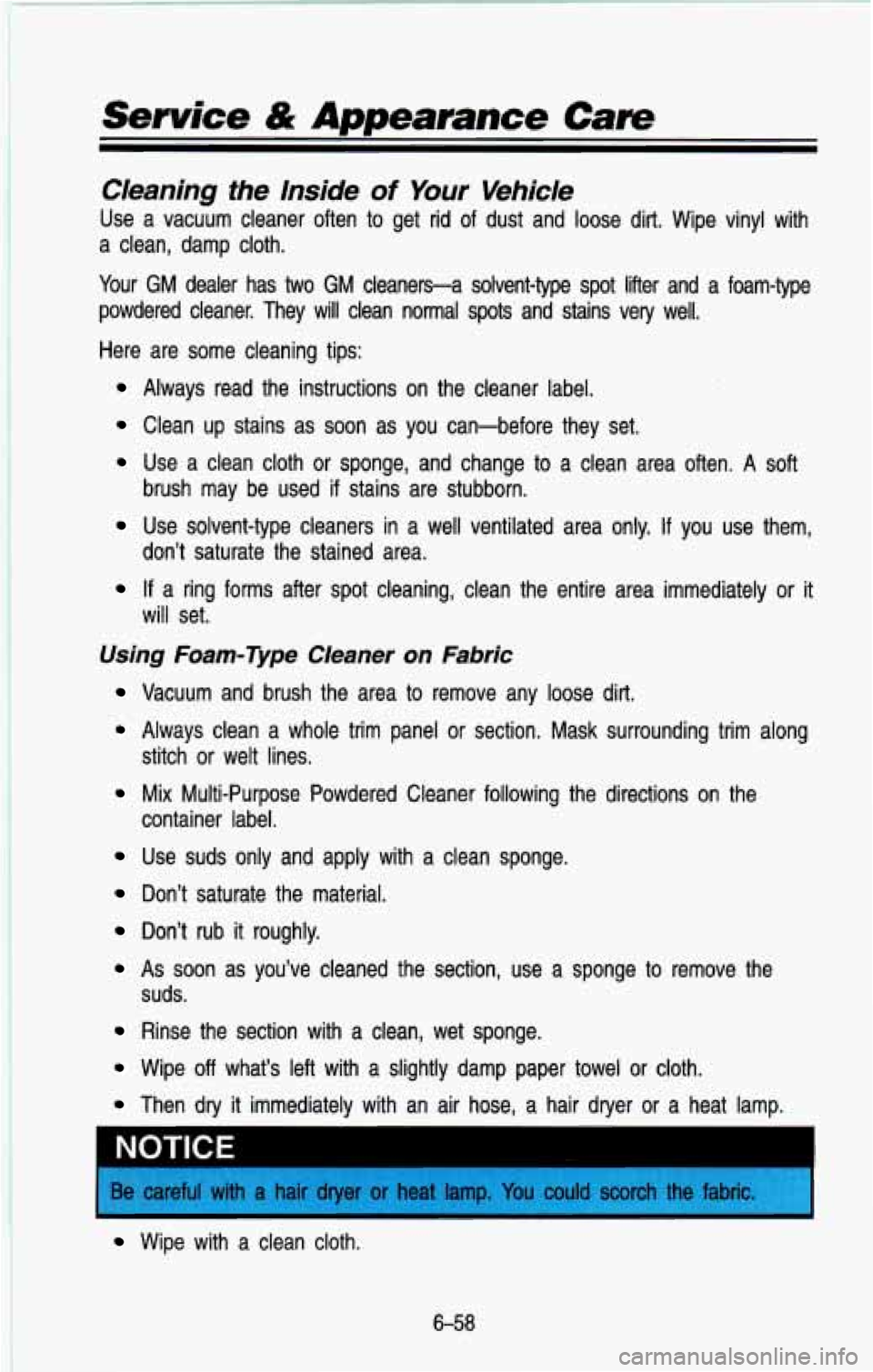
Service & Appearance Care
Cleaning the Inside of Your Vehjcle
Use a vacuum cleaner often to get rid of dust and loose dirt\
. Wipe vinyl with
a clean, damp cloth.
Your GM dealer has
two GM cleaners-a solvent-type spot lifter and a foam-type
powdered cleaner. They will clean normal spots and stains very \
well.
Here are some cleaning tips:
Always read the instructions on the cleaner label.
Clean up stains as soon as you can-before they set.
Use a clean cloth or sponge, and change to a clean area often. A soft
brush may be used
if stains are stubborn.
Use solvent-type cleaners in a well ventilated area only. If you use them,
don’t saturate the stained area.
If a ring forms after spot cleaning, clean the entire area immedi\
ately or it
will set.
Using Foam-Type CIeaner on Fabric
Vacuum and brush the area to remove any loose dirt.
Always clean a whole trim panel or section. Mask surrounding trim along
stitch or welt lines.
Mix Multi-Purpose Powdered Cleaner following the directions on t\
he
Use suds only and apply with a clean sponge.
container label.
Don’t saturate the material.
Don’t rub
it roughly.
As soon as you’ve cleaned the section, use a sponge to remove the
suds.
Rinse the section with a clean, wet sponge.
Wipe off what’s left with a slightly damp paper towel or cloth.
Then dry it immediately with an air hose, a hair dryer or a heat lamp.
NOTICE I
Be careful with a hair dryer or heat lamp. You could scorch the fabric
Wipe with a clean cloth.
6-58
Page 324 of 386
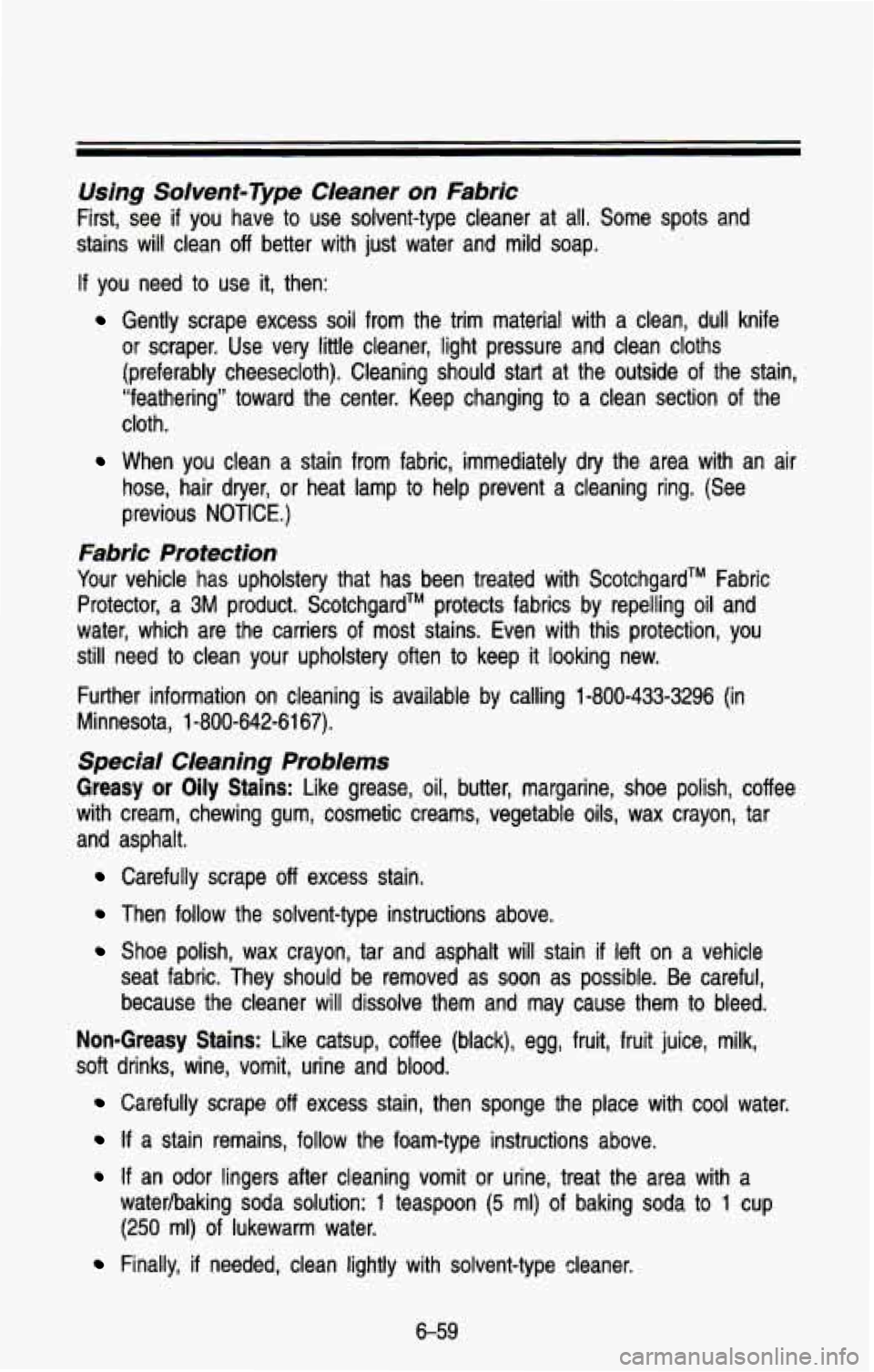
Using Solvent-Type CIeaner on Fabric
First, see if you have to use solvent-type cleaner at all. Some spots and
stains will clean
off better with just water and mild soap.
If you need to use it, then:
Gently scrape excess soil from the trim material with a clean, dull knife
or scraper. Use very little cleaner, light pressure and clean cloths
(preferably cheesecloth). Cleaning should start at the outside \
of the stain,
“feathering” toward the center. Keep changing
to a clean section of the
cloth
.
When you clean a stain from fabric, immediately dry the area with an air
hose, hair dryer, or heat lamp
to help prevent a cleaning ring. (See
previous NOTICE.)
Fabric Profection
Your vehicle has upholstery that has been treated with ScotchgardTM \
Fabric
Protector, a
3M product. ScotchgardTM protects fabrics by repelling oil and
water, which are the carriers
of most stains. Even with this protection, you
still need
to clean your upholstery often to keep it looking new.
Further information on cleaning is available by calling
1-800-433-3296 (in
Minnesota,
1-800-642-61 67).
Special Cleaning Problems
Greasy or Oily Stains: Like grease, oil, butter, margarine, shoe polish, coffee
with cream, chewing gum, cosmetic creams, vegetable oils, wax c\
rayon, tar
and asp ha1
t .
Carefully scrape off excess stain.
Then follow the solvent-type instructions above.
Shoe polish, wax crayon, tar and asphalt will stain if left on a vehicle
seat fabric. They should be removed as soon as possible. Be c\
areful, because the cleaner will dissolve them and may cause them
to bleed.
Non-Greasy Stains: Like catsup, coffee (black), egg, fruit, fruit juice, milk,
soft drinks, wine, vomit, urine and blood.
Carefully scrape off excess stain, then sponge the place with cool water.
If a stain remains, follow the foam-type instructions above.
If an odor lingers after cleaning vomit or urine, treat the area with a
watedbaking soda solution:
1 teaspoon (5 ml) of baking soda to 1 cup
(250 ml) of lukewarm water.
Finally, if needed, clean lightly with solvent-type cleaner.
6-59
Page 325 of 386
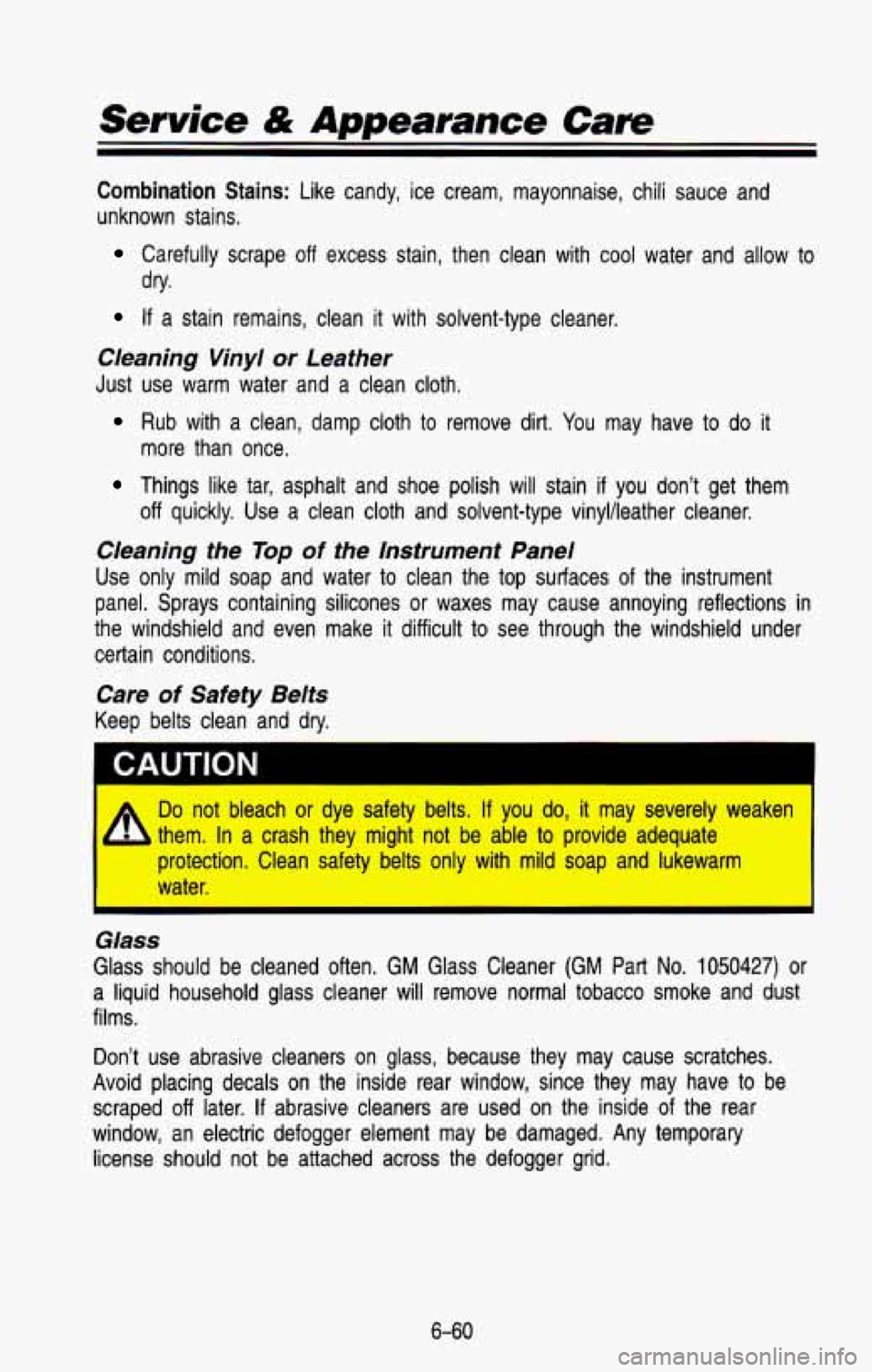
Service & Appearance Care
Combination Stains: Like candy, ice cream, mayonnaise, chili sauce and
unknown stains,
Carefully scrape off excess stain, then clean with cool water \
and allow to
If a stain remains, clean it with solvent-type cleaner.
dry.
Cleaning Vinyl or Leather
Just use warm water and a clean cloth.
Rub with a clean, damp cloth to remove dirt. You may have to do it
more than once.
Things like tar, asphalt and shoe polish will stain if you don’t get them
off quickly. Use a clean cloth and solvent-type vinylheather cleaner\
.
Cleaning the Top of the Instrument Panel
Use only mild soap and water to clean the top surfaces of th\
e instrument
panel. Sprays containing silicones or waxes may cause annoying \
reflections in
the windshield and even make
it difficult to see through the windshield under
certain conditions.
Care of Safety Belts
Keep belts clean and dry.
Do not bleach or dye safety belts. If you do, it may severely weaken
them. In a crash they might not be able to provide adequate
protection. Clean
safety belts only with mild soap and lukewarm
I water.
Glass
Glass should be cleaned often. GM Glass Cleaner (GM Part No. 1050427) or
a liquid household glass cleaner will remove normal tobacco smoke \
and dust
films.
Don’t use abrasive cleaners
on glass, because they may cause scratches.
Avoid placing decals on the inside rear window, since they may\
have to be scraped
off later. If abrasive cleaners are used on the inside of the rear
window, an electric defogger element may be damaged. Any temporary
iicense should not be attached across the defogger grid.
6-60
Page 326 of 386
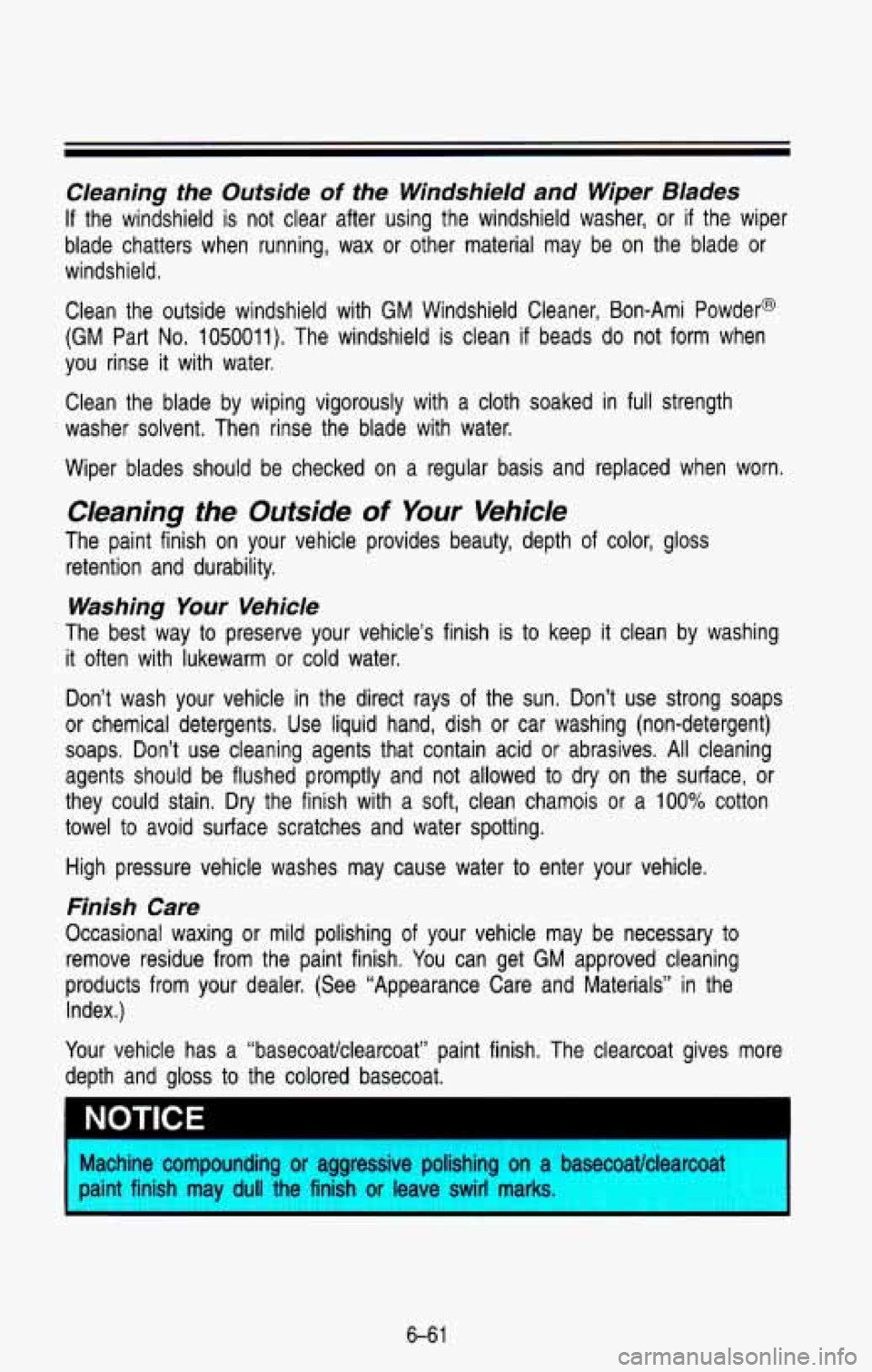
Cleaning the Outside of the Windshield and Wiper Blades
If the windshield is not clear after using the windshield washer, or if the wiper
blade chatters when running, wax or other material may be on the blade or
windshield,
Clean the outside windshield with
GM Windshield Cleaner, Bon-Ami Powder@
(GM Part No. 1050011). The windshield is clean if beads do not form when
you rinse it with water.
Clean the blade by wiping vigorously with a cloth soaked in full strength
washer solvent. Then rinse the blade with water.
Wiper blades should be checked on a regular basis and replaced\
when worn.
Cleaning the Outside of Your Vehicle
The paint finish on your vehicle provides beauty, depth of color, gloss
retention and durability.
Washing Your Vehicle
The best way to preserve your vehicle’s finish is to keep it clean by washing
it often with lukewarm or cold water.
Don’t wash your vehicle in the direct rays
of the sun, Don’t use strong soaps
or chemical detergents. Use liquid hand, dish or car washing (non-detergent)
soaps. Don’t use cleaning agents that contain acid
or abrasives. All cleaning
agents should be flushed promptly and not allowed to dry on t\
he surface, or
they could stain. Dry the finish with a soft, clean chamois or a
100% cotton
towel to avoid surface scratches and water spotting.
High pressure vehicle washes may cause water to enter your vehicle.
Finish Care
Occasional waxing or mild polishing of your vehicle may be necessary to
remove residue from the paint finish. You can get GM approved cleaning
products from your dealer. (See “Appearance Care and Materia\
ls” in the
Index.)
Your vehicle has a “basecoatlclearcoat” paint finish. The clearcoat gives more
depth and
gloss to the colored basecoat.
Machine compounding
or aggressive polishing on a basecoatlctearcoat I f
paint finish may dull the finish or leave swirl marks.
6-6 1
Page 327 of 386
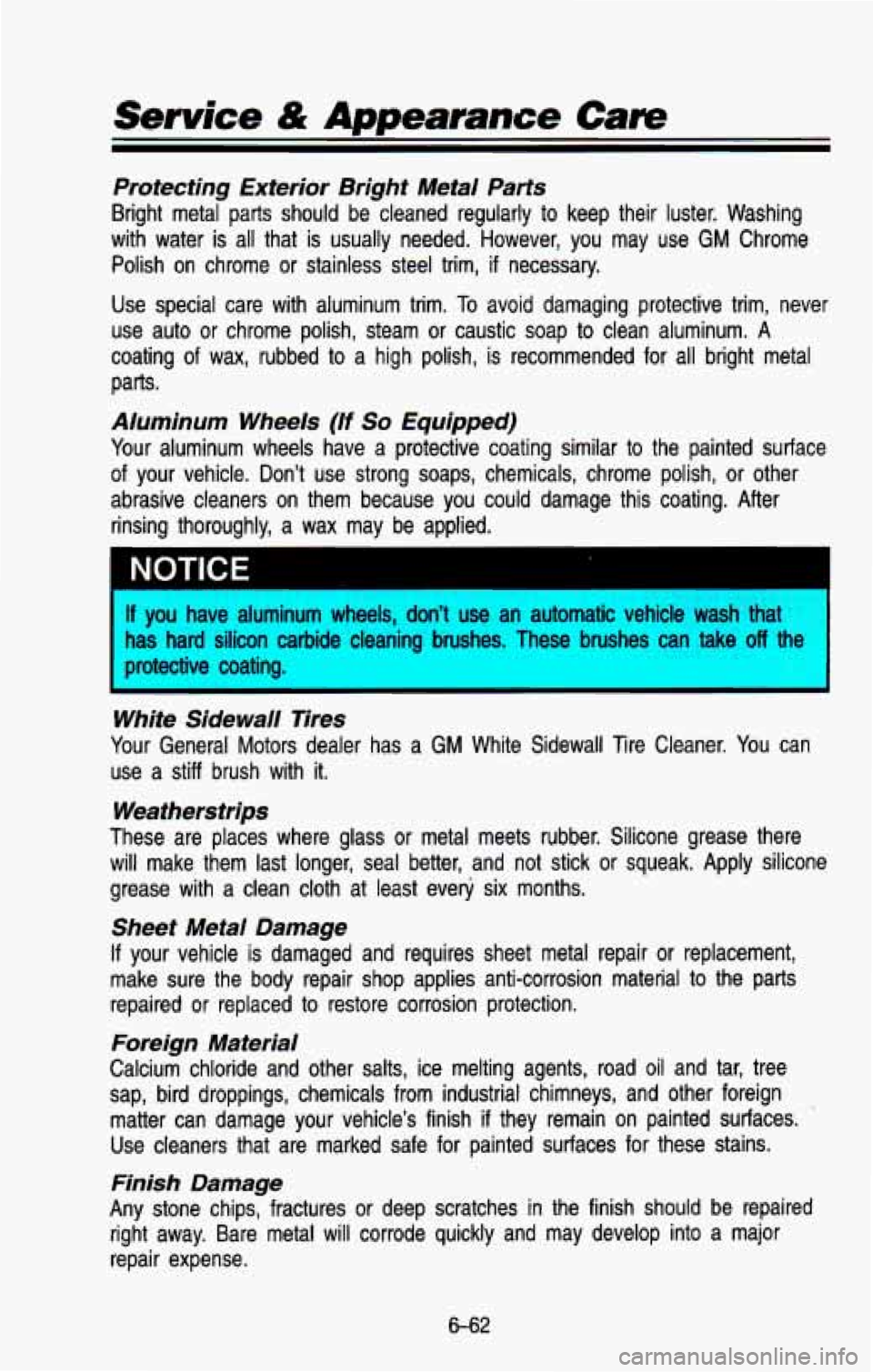
Protecting Exterior Bright Metal Parts
Bright metal parts should be cleaned regularly to keep their l\
uster. Washing
with water is all that is usually needed. However, you may use
GM Chrome
Polish on chrome or stainless steel trim,
if necessary.
Use special care with aluminum trim.
To avoid damaging protective trim, never
use auto or chrome polish, steam or caustic soap
to clean aluminum. A
coating of wax, rubbed to a high polish, is recommended for all bright metal
parts.
Aluminum Wheels (If So Equipped)
Your aluminum wheels have a protective coating similar to the painted surface
of your vehicle. Don’t use strong soaps, chemicals, chrome polis\
h, or other
abrasive cleaners on them because you could damage this coating\
. After
rinsing thoroughly, a wax may be apptied.
NOTICE 1
f you have aluminum wheels, don’t use an automatic vehicle wash that
?as hard silicon carbide cleaning brushes. These brushes can take
off the
xotective coating.
White Sidewall Tires
Your General Motors dealer has a GM White Sidewall Tire Cleaner. You can
use a stiff brush with
it.
Weatherstrips
These are places where glass or metal meets rubber. Silicone g\
rease there
will make them last longer, seal better, and not stick or squeak. Apply silic\
one
grease with a clean cloth at least eve@ six months.
Sheet Metal Damage
If your vehicle is damaged and requires sheet metal repair or replacement,
make sure the body repair shop applies anti-corrosion material
to the parts
repaired or replaced
to restore corrosion protection.
Foreign Material
Calcium chloride and other salts, ice melting agents, road oil \
and tar, tree
sap, bird droppings, chemicals from industrial chimneys, and 0the.r foreign\
matter can damage your vehicle’s finish
if they remain on painted surfaces.
Use cleaners that are marked safe for painted surfaces for the\
se stains.
Finish Damage
Any stone chips, fractures or deep scratches in the finish should be repaired
right away. Bare metal will corrode quickty and may develop into a major
repair expense.
6-62
Page 328 of 386
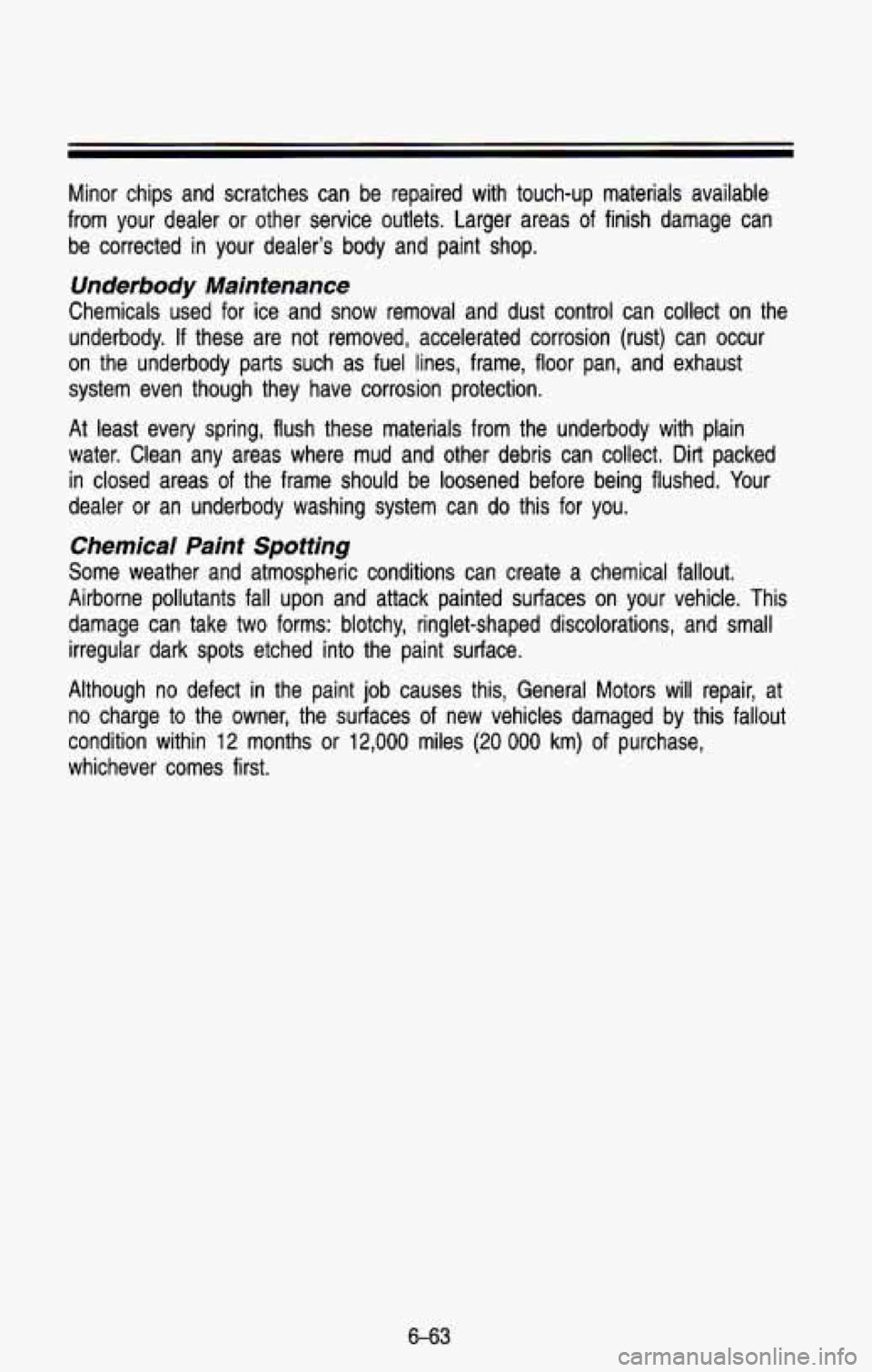
Minor chips and scratches can be repaired with touch-up materia\
ls available
from your dealer or other service outlets. Larger areas of fin\
ish damage can be corrected in your dealer’s body and paint shop.
Underbody Maintenance
Chemicals used for ice and snow removal and dust control can collect on the
underbody.
If these are not removed, accelerated corrosion (rust) can occur
on the underbody parts such as fuel lines, frame, floor pan, and exhaust
system even though they have corrosion protection.
At least every spring, flush these materials from the underbody wi\
th plain
water. Clean any areas where mud and other debris can collect.\
Dirt packed in closed areas of the frame should be loosened before being flushed. Your
dealer or an underbody washing system can do this for you.
Chemical Paint Spotting
Some weather and atmospheric conditions can create a chemical fallout.
Airborne pollutants fall upon and attack painted surfaces on yo\
ur vehicle. This
damage can take two forms: blotchy, ringlet-shaped discolorations\
, and small irregular dark spots etched into the paint surface.
Although no defect in the paint
job causes this, General Motors will repair, at
no charge to the owner, the surfaces of new vehicles damaged by \
this fallout
condition within
12 months or 12,000 miles (20 000 km) of purchase,
whichever comes first.
6-63
Page 329 of 386
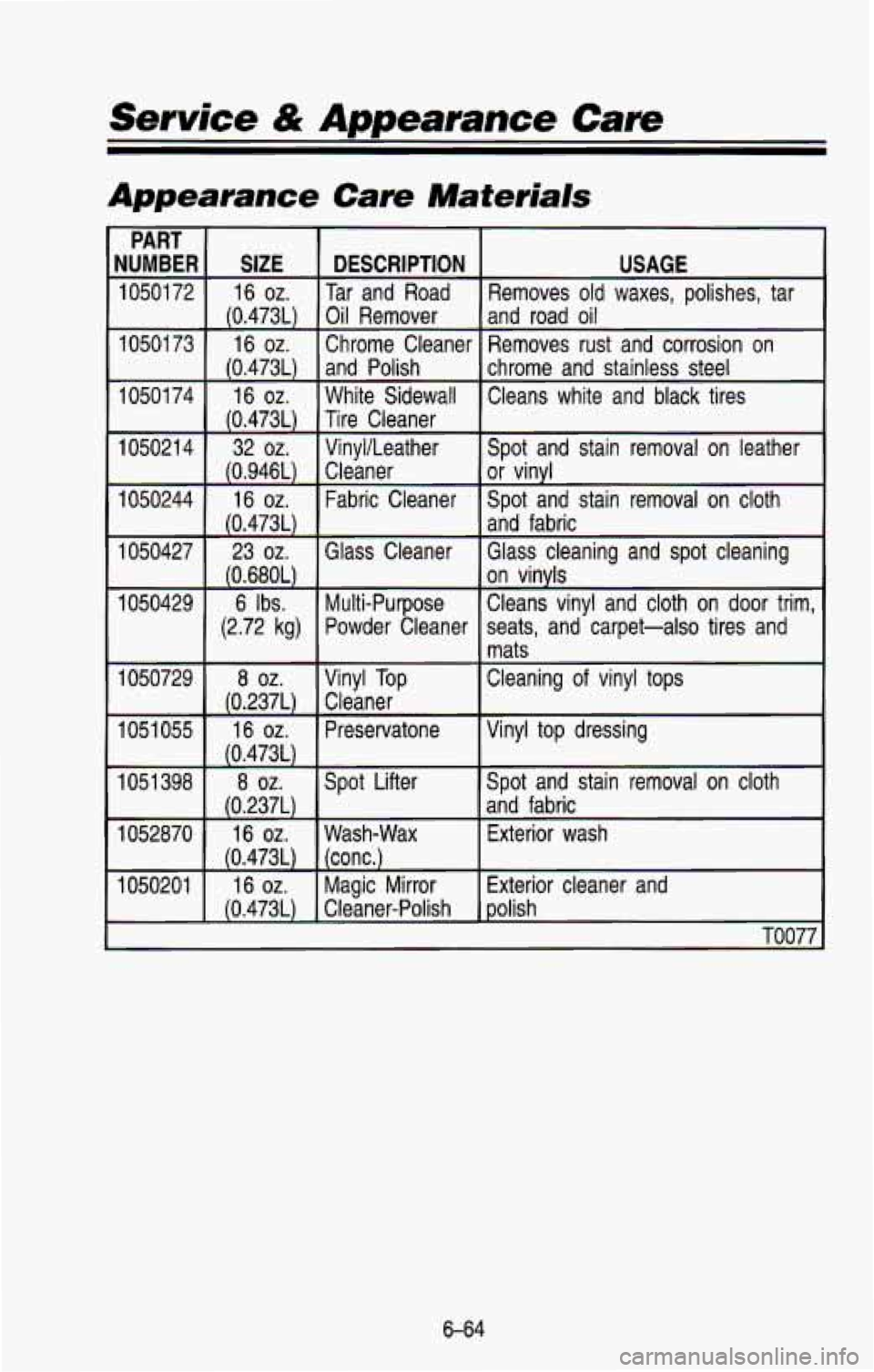
Service & Appearance Care
Appearance Care Materials
PART I I I
NUMBER SIZE DESCRIPTION USAGE
1050172 16 02. Tar and Road Removes old waxes, polishes, tar
1050173 16
oz. Chrome Cleaner Removes rust and corrosion on
I0501 74 16
02. White Sidewall Cleans white and black tires
(0.473L)
Oil Remover and road oil
(0.473L) and Polish chrome and stainless steel
(0.473L) Tire Cleaner
1050214 32
oz. VinvVLeather Spot and stain removal on leather
(0.946L) Cleaner or vinyl
(0.473L) and fabric
1050244 16 02. Fabric Cleaner Spot and stain removal on cloth
I050427 23
02. Glass Cleaner Glass cleanina and sDot cleaning I
(0.680L)
"
on vinyls
-
1050429 6 Ibs. Multi-PurDose Cleans vinvl and cloth on door tr\
im,
(2.72 kg) Powder cleaner seats, and'carpet-also tires and
mats
1050729 8
02. Vinyl Top
Cleaning of vinyl tops
1051
055 16 02. Preservatone Vinyl top dressing
IO51
398 8 02. Spot Lifter Spot and stain removal on cloth
1052870 16
02. Wash-Wax Exterior wash
(0.237L) Cleaner
(0.473L)
(0.237L)
and fabric
(0.473L) (conc.)
1050201 16
02. Magic Mirror Exterior cleaner and
I (0.473L) I Cleaner-Polish 1 polish
TO077
6-64
Page 330 of 386
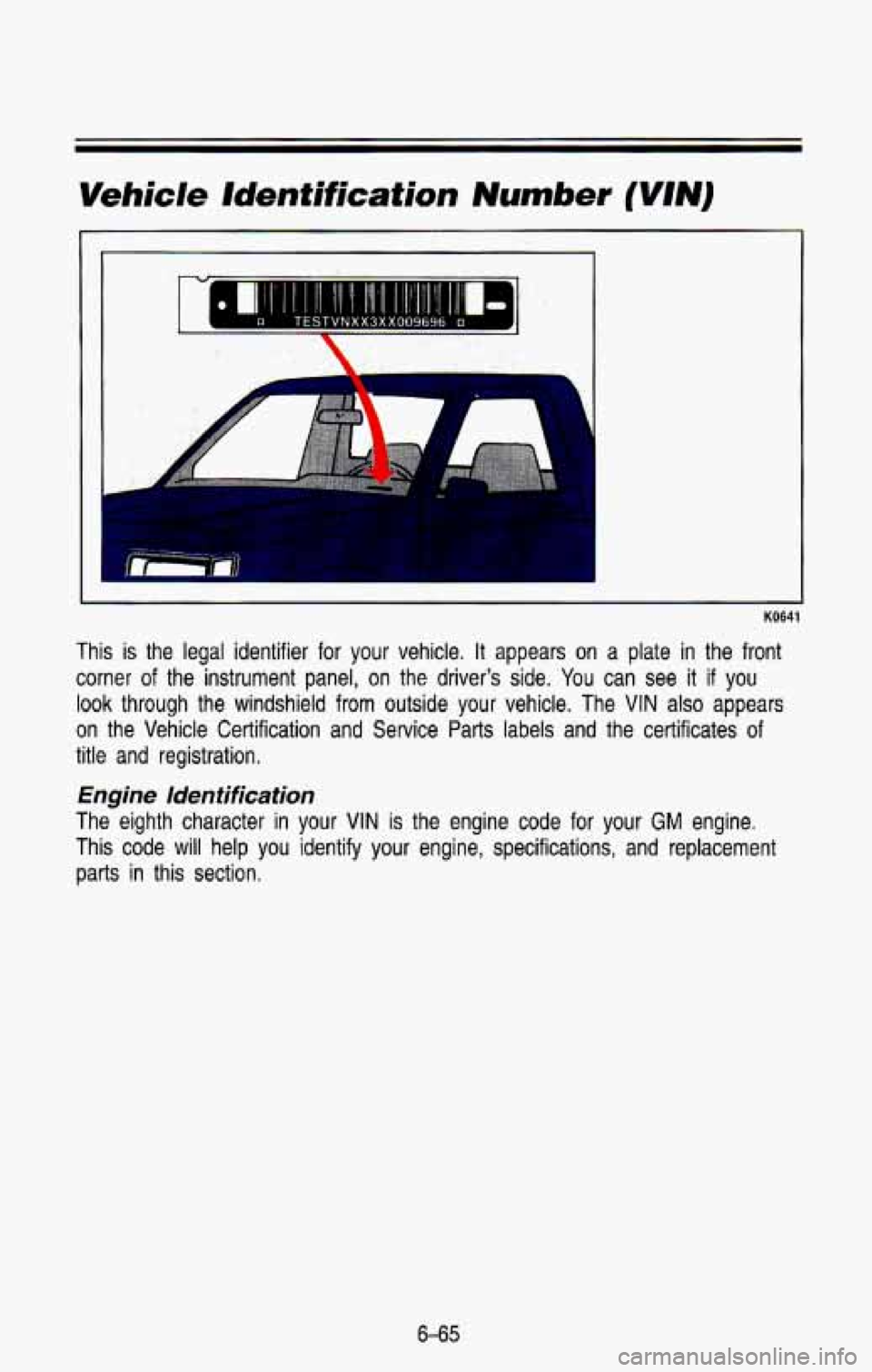
Vehicle ldentification Number ( I) m
t-
KO641
This is the legal identifier for your vehicle. It appears on a plate in the front
corner of the instrument panel,
on the driver's side. You can see it if you
look through the windshield from outside your vehicle. The VIN also appears
on the Vehicle Certification and Service Parts labels and the \
certificates
of
title and registration.
Engine Identification
The eighth character in your VIN is the engine code for your GM engine.
This code will help
you identify your engine, specifications, and replacement
parts in this section.
6-65